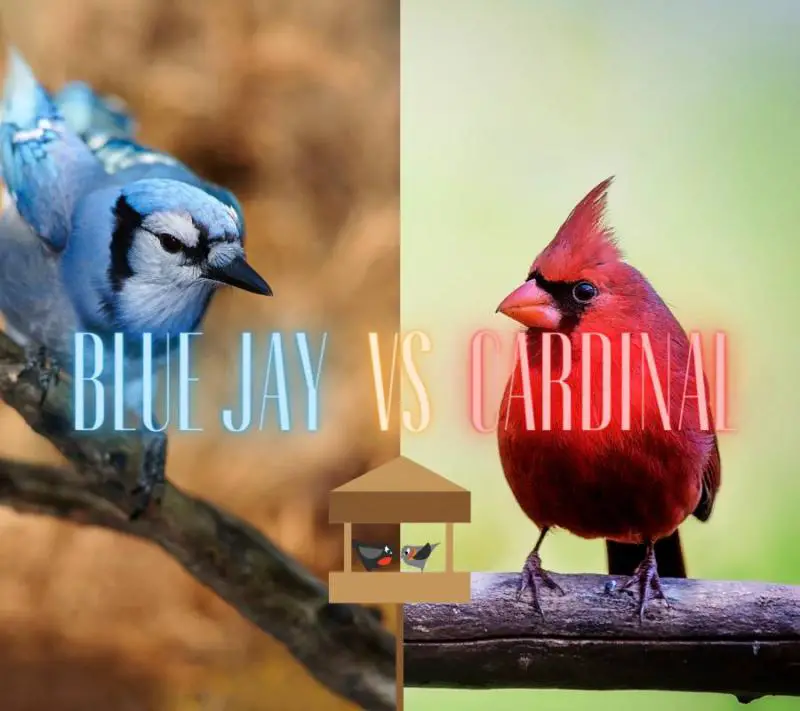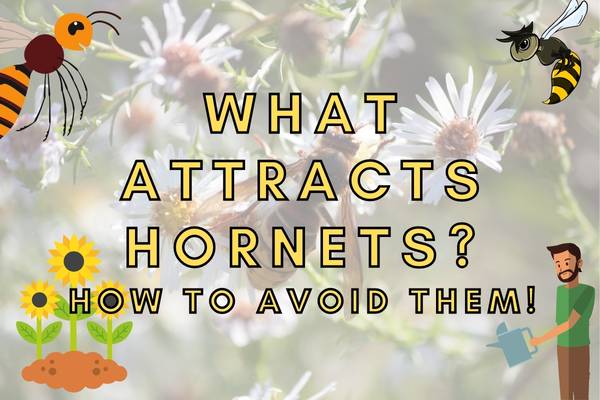The Blue Jay and the northern cardinal are both brightly colored, charismatic birds featured as sports mascots and state icons in North America.
Both are common birds in urban gardens throughout Southeastern Canada and eastern and central United States. As common birds with a similar distribution, they are bound to bump into each other from time to time.
So, what do encounters between these two species look like, and which one would win in a fight?
As the bigger, bolder species, Blue Jays may appear to have the upper hand. Blue Jays will often chase Northern Cardinals from bird feeders and predate on their eggs and young. However, the northern cardinal is not defenseless, and will often fight back!
Northern cardinals will aggressively attack any Blue Jays spotted near their nest. In neutral territory, northern cardinals can benefit from the loud alarm call of the Blue Jay and its ability to ward off predators.
To better understand this complicated relationship, we take a closer look at the interactions between them.
Are Blue Jays and Northern Cardinals related?
The crest and posture of the Blue Jay and northern cardinal give them a similar silhouette and might suggest that they are related.
However, apart from them both being songbirds, the Blue Jay and the northern cardinal are not closely related.
The Blue Jay is part of the crow family (Corvidae), which includes crows, ravens, magpies, and nutcrackers, rather than being related to woodpeckers as some people have suggested.
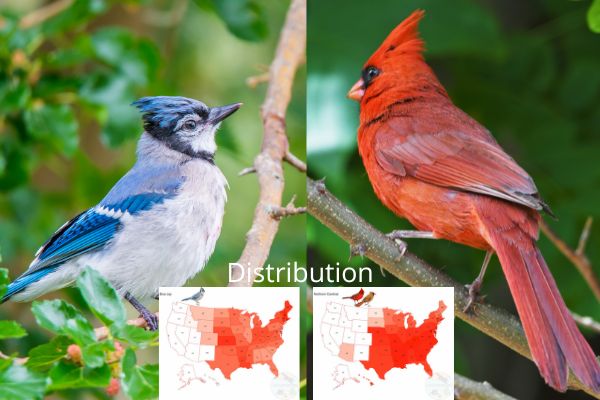
The northern cardinal is from the cardinal family (Cardinalidae), which includes Tanagers, Grosbeaks, and Buntings.
Which is more aggressive – the Blue Jay or the Northern Cardinal?
Both the Blue Jay and the Northern Cardinal aggressively defend their territories, especially during the breeding season.
Cardinals are known to attack their own reflections in windows, mistaking them for intruders!
Blue Jays are bolder in their territorial defense and will attack other birds, cats, dogs, and even humans.
So how do these two birds compare to each other in the pecking order?
In a study that ranked bird species from 1 (least dominant) to 136 (most dominant), the Blue Jay was ranked 87th and the northern cardinal 64th (reference 1).
At the birdfeeder, the Blue Jay is likely to win in a contest against the northern cardinal. The Blue Jay, at ~3 oz, is almost double the size of the northern cardinal (~1.5 oz).

Click the image to enlarge.
Apart from its larger size, the Blue Jay is also intelligent, aggressive, and bold, while the northern cardinal is cautious by nature.
Blue Jays can work together in large flocks to chase away other birds. Additionally, the Blue Jay’s ability to mimic the calls of predators can send birds scattering, giving them free access to bird feeders without a fight.
Interestingly, while Blue Jays and Cardinal may seem aggressive towards other bird species, they are in fact most aggressive towards other individuals of their own kind!
That is because intra-species (as opposed to inter-species) aggression is actually more common, there is a higher chance that two Blue-Jays at a bird feeder will chase each other away rather than pairing up to scare away the lone Cardinal!
Data from a study conducted by William E. Davis, Jr. published in the Bird Observed shows that only 23% of Blue Jay aggressions were targeted against other species and the remaining 77 against other Blue Jays!
The same is true for the Northern Cardinal, where little more than half of its forceful attempts to scare away another bird at the bird feeder, is targeted towards its own kind!
So, I have made a figure to display the most common inter-species interactions at the bird feeder using some of the most common backyard birds as examples.
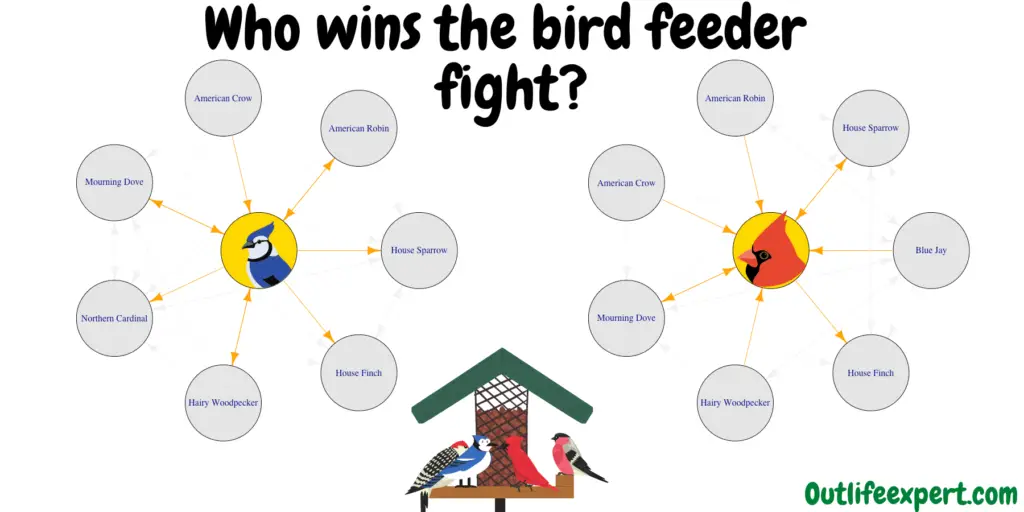
The orange arrows indicate direct interactions with either the Blue Jay (left) or the Northern Cardinal (Right).
The gray arrows vaguely visible in the background, represent all interactions that do not involve the two species in question.
If the arrow points in both directions, an equal number of fights are won by each bird.
Looking at the figure of bird interactions above, we can see that the Blue Jay not only scares away the Cardinal but also other smaller birds!
The Blue Jay usually wins power displays against the House finch and it also dominates the House Sparrow!
The Blue Jay can scare away the Cardinal, but the American Crow will scare away the Blue Jay and the Hairy Woodpecker and Blue Jay are equals.
The Northern Cardinal is scared away by the Blue Jay but also, somewhat surprisingly, by the American Robin – an aggressive little fella!
It can, however, scare away the smaller birds such as the House Finch, but is somewhat equal when competing with the House Sparrow and even the Mourning Dove.
The Mourning Dove is one of the larger birds showing up at bird feeders, but it is not very aggressive. It is actually submissive enough, that both the Blue Jay and the Northern Cardinal may occasionally chase it off.
Are Blue Jays aggressive towards cardinals?
Even though Blue Jays and northern cardinals have different diets, they still compete for food.
The Blue Jay’s varied diet includes fruits, seeds, insects, and small animals. They are also known to prey on the eggs and chicks of other birds, including those of the northern cardinal, spreading further animosity between the two species.
In contrast, the northern cardinal’s diet consists mostly of seeds. Even though insects don’t form a large part of the adult Northern Cardinal’s diet, their chicks depend almost entirely on insects. Therefore, both species will compete for sunflowers, peanuts, fruits, and insects at bird feeders.
Despite them being enemies at the bird feeder, and occasional predators, Northern Cardinals can benefit from feeding in areas where Blue Jays are present, because of the Blue Jay’s load alarm call and ability to chase away predators.
Northern Cardinals will attack Blue Jays close to their nests. Males and females will attack as a pair or join other birds to mob Blue Jays and protect their nests.
However, it is not certain how effective they are at defending their nests. Their defense is often of low intensity and does not seem to play a big role in nest success (reference 5).
Predation is a big cause of nest losses for the Northern Cardinal, and Blue Jays are not the only predators of northern cardinal nests. In fact, investigations into the stomach contents of Blue Jays suggest that eggs and chicks only form an occasional part of their diet (reference 6).
Other nest predators of Northern Cardinal eggs and fledglings include snakes, raccoons, and squirrels (yes, squirrels eat baby birds!).
Northern Cardinals seem to have adapted to high rates of nest predation. In the case of nest failure, the northern cardinal can lay a new clutch of eggs within four days.
They have a long breeding season and can have multiple successful broods per season. Therefore, despite the many reports of Blue Jays raiding northern cardinal nests, they don’t seem to negatively affect the northern cardinal’s breeding success.
Therefore, most birds avoid it unless their survival is at stake. Even then, most aggressive interactions take place between birds of the same species.
Competition is often harsher between individuals of the same or closely related (reference 7) species because they compete for the same resources.
It is important to remember that most interactions between birds are peaceful – no one is interested in conflict because conflict is energetically costly and comes with the risk of injury.
Final thoughts
A bird’s ability to win a fight does not necessarily indicate its ability to survive. However, competition has great ecological, behavioral, and conservation implications for species and these need to be considered when predicting future impacts on these species.
The Blue Jay and the northern cardinal share a large distribution, implying that they get along well enough to co-exist. Both species are currently listed as the least concern.
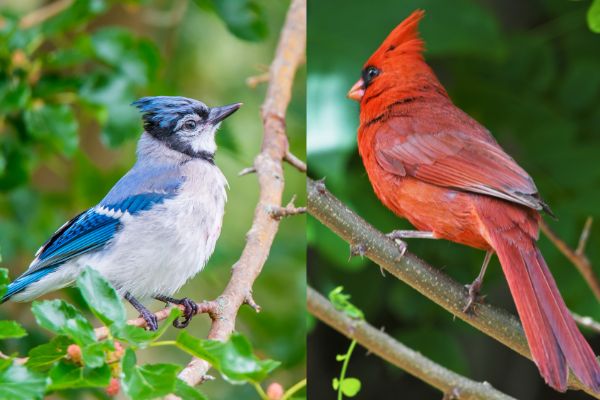
However, it is not known what the impact of climate change or increased urbanization will be on these species’ distribution and conservation status.
If resources become increasingly scarce, competition between these two and other bird species might increase.
If you are interested in knowing more about how birds interact with each other at the bird feeder, check out my other articles on what garden birds are afraid of crows and whether the robin is considered to rank high or low in the bird feeder hierarchy!
Interested in backyard birds?
Are you interested in how the backyard birds in your state compare to other states?
Then check out my other blog posts below:
- Backyard birds of Alabama
- Backyard birds of Colorado
- Backyard birds of Delaware
- Backyard birds of Georgia
- Backyard birds of Hawaii
- Backyard birds of Illinois
- Backyard birds of Iowa
- Backyard birds of Kentucky
- Backyard birds of Louisiana
- Backyard birds of Maryland
- Backyard birds of Massachusetts
- Backyard birds of Missouri
- Backyard birds of Nebraska
- Backyard birds of New York
- Backyard birds of North Carolina
- Backyard birds of Oklahoma
- Backyard birds of Rhode Island
- Backyard birds of South Carolina
- Backyard birds of Tennessee
- Backyard birds of Texas
- Backyard birds of Virginia
- Backyard birds of West Virginia
- Backyard birds of Wisconsin
- Backyard birds of Wyoming
And in Canada:
- Backyard birds of Ontario
- Backyard birds of Prince Edward Island
- Backyard birds of Saskatchewan
- Backyard birds of Quebec
Not on the list? Check out the rest of my posts on backyard birds here!
Maybe you would like to know if the Blue Jay or Cardinal dominates in the bird feeder hierarchy or how birds such as seagulls sleep at night? Or why mourning doves poop so much.
If you are interested in posters and other wall arts etc. with drawings of all the backyard birds you have just read about, check out my portfolio over at Redbubble:
References:
Scientific articles:
- Fighting over food unites the birds of North America in a continental dominance hierarchy. 2017. Miller ET, Bonter DN, Eldermire C, Freeman BG, Greig EI, Harmon LJ, Lisle C, Hochachka WM. Behavioural Ecology, 28(6): 1454–1463. https://doi.org/10.1093/beheco/arx108
- Aggression by Birds at Winter Bird Feeders. 2009. Davis WE, Jr. Bird Observer, 37: 13- 17.
- Aggressive encounter of a group of Blue Jays (Cyanocitta cristata) toward a group of scissor-tailed flycatchers (Tyrannus forficatus). 2014. Ladine TA. The Southwestern Naturalist, 59(3): 407–409. https://www.jstor.org/stable/44732128
- Shifts in Dominant Nest Predators Along a Rural-To-Urban Landscape Gradient. 2011. Rodewald AD, Kearns LJ. The Condor, 113 (4): 899–906, https://doi.org/10.1525/cond.2011.100132
- Northern Cardinal Sexes Defend Nests Equally. 1997. Paul M. Nealen PM, and Randall Breitwisch R. The Wilson Bulletin, 109(2): 269-278. http://www.jstor.org/stable/4163810
- https://www.allaboutbirds.org/guide/Blue_Jay/lifehistory
- Interspecific aggression and habitat selection by Amazonian birds. 1995. Robinson SK, Terborgh J. Journal of Animal Ecology, 64: 1-11. http://www.jstor.org/stable/5822
Other references on general bird behavior used in this post:
https://www.allaboutbirds.org/news/when-136-bird-species-show-up-at-a-feeder-which-one-wins/
https://feederwatch.org/blog/who-is-the-toughest-bird/
Want to follow along with what birds visit your bird feeder, check this automated camera feeder out:
- Photographs and identifies birds coming to your bird feeder!
- Notifies you via the app whenever a bird stops by!
- Excellent resolution and battery performance with the 6MP image sensor.
- Connect from anywhere with internet access (watch birds even when you are not at home!)
- Count the birds visiting your feeder and contribute to projects such as FeederWatch!

